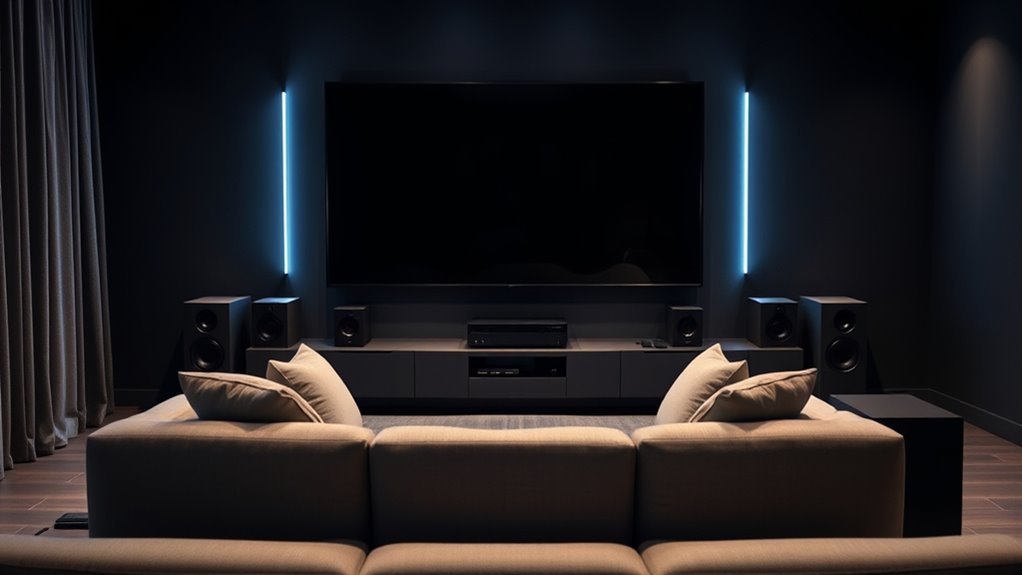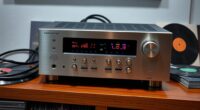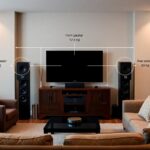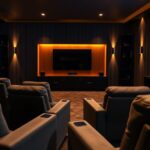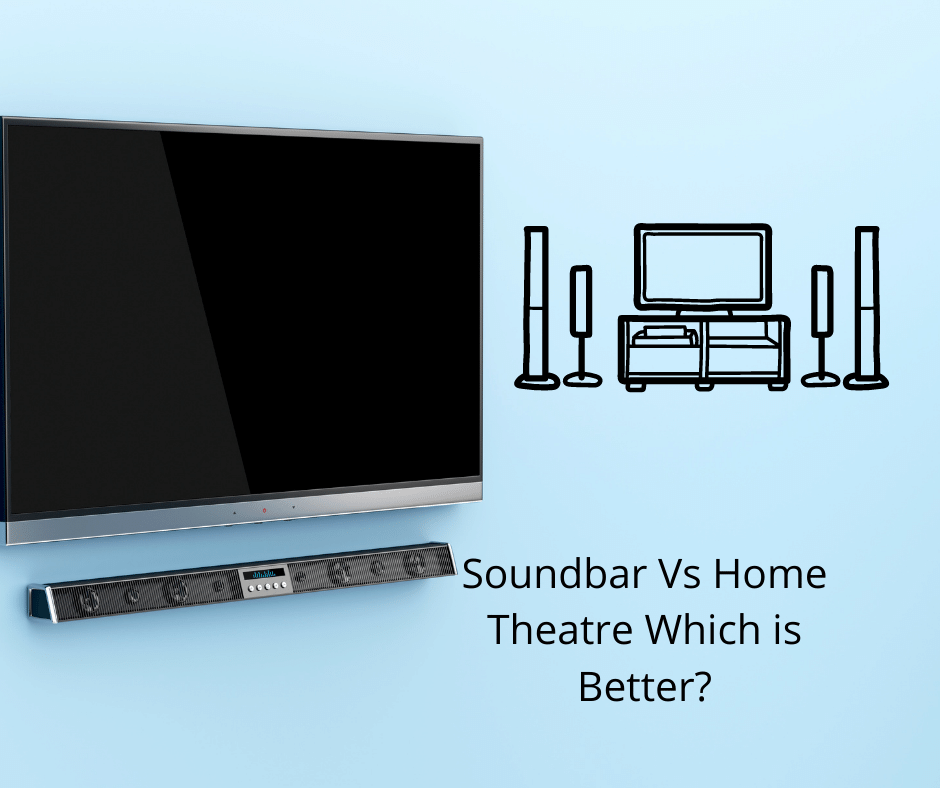To set up a home theater, start with a reliable display like an OLED or large LED screen that matches your room size and offers high resolution for sharp images. Add a good audio system with surround sound, including an AV receiver, quality speakers, and a subwoofer for deep bass. Include source devices such as streaming devices or Blu-ray players, and guarantee your internet connection is strong. Control lighting with dimmable or smart options and create a comfortable environment with proper seating and acoustic treatments. If you keep exploring, you’ll discover how each component perfectly comes together for an immersive experience.
Key Takeaways
- Choose a reliable high-resolution display that matches room size for optimal viewing.
- Incorporate a surround sound system with a good AV receiver and properly placed speakers.
- Select compatible source devices like streaming, Blu-ray, or gaming consoles with organized setup.
- Control lighting with dimmable or smart options to reduce glare and enhance picture quality.
- Ensure comfortable seating and acoustic treatments to create an immersive, distraction-free environment.
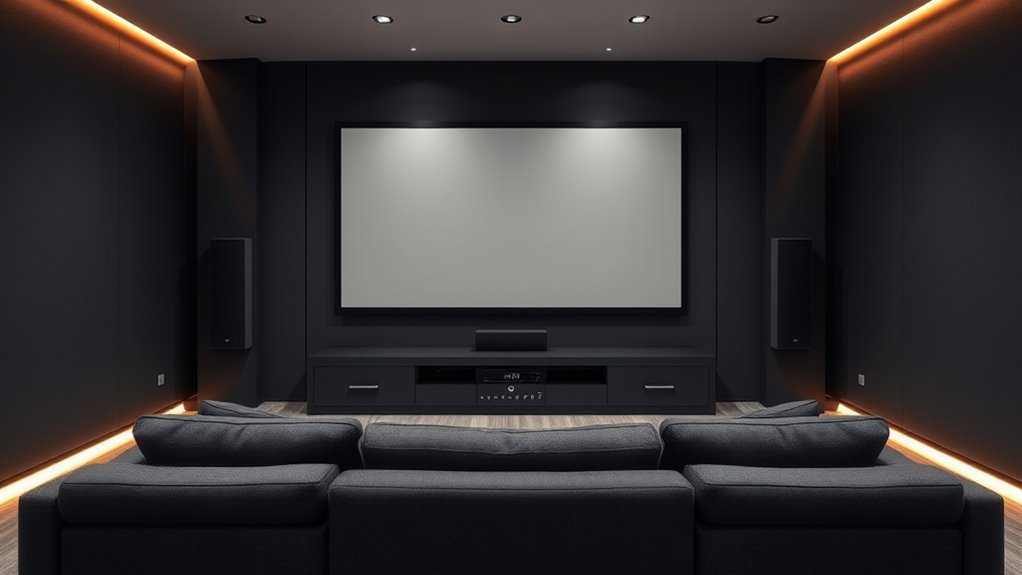
Ever wondered how to create the perfect home theater experience? It all begins with understanding the essential components that bring your movie nights to life. First, you need a reliable display. Whether you opt for a large-screen LED, OLED, or a projector with a big screen, your choice sets the foundation for immersive visuals. Consider the size of your room and how close you’ll sit to determine the best screen size. A bigger, high-resolution display ensures sharper, more vibrant images, making every scene pop.
A reliable, high-resolution display sets the foundation for immersive home theater visuals.
Next, the heart of your home theater is the audio system. Good sound quality can dramatically enhance your viewing experience. You’ll want to invest in a quality AV receiver that can handle multiple inputs and power your speakers efficiently. Surround sound speakers are key: a 5.1 or 7.1 configuration creates an immersive environment, with speakers strategically placed around your room for optimal sound distribution. Don’t forget a solid subwoofer to deliver those deep bass notes that make explosions and musical scores feel more impactful. Proper speaker placement and calibration are crucial—you want sound to feel natural and enveloping, not just coming from one direction.
The source devices are also vital. Whether you’re streaming content through a smart TV, using a dedicated Blu-ray player, or connecting gaming consoles, ensure they are compatible with your display and audio setup. A reliable internet connection is necessary for streaming high-definition content without buffering interruptions. Keep your devices organized and accessible, so switching between sources remains seamless.
Lighting plays a subtle but important role. You want to avoid glare on the screen and create a cozy environment. Blackout curtains or dimmable lighting help control ambient light, making your picture clearer and colors richer. Consider installing smart lighting that can be dimmed or turned off remotely, so you don’t have to get up during crucial scenes.
Finally, comfort and acoustics matter. Use comfortable seating positioned at the right distance from the screen for optimal viewing. Rugs, curtains, and acoustic panels can absorb sound reflections and reduce echo, improving overall sound quality. Every element should work together to craft an environment where you forget about the outside world and focus solely on the entertainment. Incorporating soundproofing techniques can further enhance the experience by minimizing external noise disturbances.
Frequently Asked Questions
What Is the Ideal Room Size for a Home Theater?
Think of your home theater as a cozy nest for immersive entertainment. Ideally, a room between 12×10 and 20×15 feet strikes a balance, providing enough space for great sound and visuals without feeling cavernous. Larger rooms can cause sound echo, while smaller ones might be cramped. Your goal is to create a space where every seat feels like front-row, so choose a size that matches your needs and keeps your experience sharp.
How Do I Choose the Right Speaker Placement?
To select the right speaker placement, start by positioning your front speakers at ear level and equidistant from your seating. Keep them a few feet apart, forming an angle toward your listening position. Place the center speaker directly above or below your screen, and situate surround speakers slightly behind and to the sides of your seating area. Adjust placement based on room acoustics to guarantee balanced sound and an immersive experience.
What Is the Best Budget for a Beginner Setup?
When figuring out your budget, start small and prioritize quality over quantity. For a beginner setup, around $300 to $500 is a good starting point. You can find decent speakers, a receiver, and a basic display within this range. Focus on essential components first, then upgrade as you go. Remember, investing wisely now makes your home theater experience more enjoyable without breaking the bank.
How Do I Calibrate My Audio for Optimal Sound?
Your question about calibrating audio might feel overwhelming, but it’s easier than you think—think of it as tuning your sound to perfection, like a maestro with an orchestra. Start by using your receiver’s calibration microphone and auto-calibration feature. Adjust speaker levels and distances if needed. Listen carefully, and fine-tune bass and treble to your liking. With a little patience, your sound will blow your mind!
What Streaming Services Are Compatible With Home Theater Systems?
When asking about streaming services compatible with your home theater system, you can generally access popular platforms like Netflix, Hulu, Amazon Prime Video, and Disney+ through devices connected to your system. These services work via apps on smart TVs, streaming devices, or gaming consoles. Just make certain your device supports the app, and you’ll enjoy seamless streaming with excellent audio and video quality, making your home theater experience even better.
Conclusion
Now that you’ve got the essentials down, creating your perfect home theater is within reach. Just remember, even in this digital age, a good old-fashioned popcorn maker can bring the magic alive—think of it as your secret weapon for movie nights! Keep experimenting with your setup, and soon you’ll be enjoying blockbuster hits in the comfort of your own castle. So, get ready to kick back, relax, and enjoy the show!
Hello, I’m Art, and I’m excited to be a part of the 1Home Theatre Projector team. As a writer, I’m here to contribute my knowledge and insights to help you achieve the ultimate home cinema experience. I understand that making decisions in the world of home entertainment can be complex, and I’m here to simplify the process for you.
